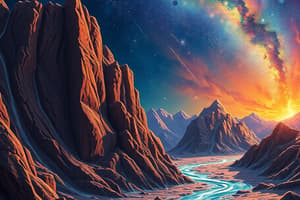Podcast
Questions and Answers
What type of boundaries are characterized by plates coming together?
What type of boundaries are characterized by plates coming together?
- Divergent boundaries
- Convergent boundaries (correct)
- Transform boundaries
- Subduction boundaries
Which subatomic particle has a neutral charge?
Which subatomic particle has a neutral charge?
- Positron
- Electron
- Neutron (correct)
- Proton
What is the term for when an oceanic plate slides beneath a continental plate?
What is the term for when an oceanic plate slides beneath a continental plate?
- Subduction (correct)
- Divergent
- Seafloor spreading
- Transform boundaries
Where are protons and neutrons located within an atom?
Where are protons and neutrons located within an atom?
Which subatomic particle has a negative charge?
Which subatomic particle has a negative charge?
What is the total number of protons and neutrons in an atomic nucleus called?
What is the total number of protons and neutrons in an atomic nucleus called?
What layer of the Earth are the plates made of?
What layer of the Earth are the plates made of?
Which layer of the Earth do the plates sit on top of?
Which layer of the Earth do the plates sit on top of?
What is the focus of an earthquake?
What is the focus of an earthquake?
What is the epicenter of an earthquake?
What is the epicenter of an earthquake?
Which type of seismic wave can travel through both solids and liquids?
Which type of seismic wave can travel through both solids and liquids?
What happens to P-waves and S-waves as they move further away from the epicenter?
What happens to P-waves and S-waves as they move further away from the epicenter?
What is the main difference between felsic and mafic lava?
What is the main difference between felsic and mafic lava?
What distinguishes intrusive igneous rocks from extrusive igneous rocks?
What distinguishes intrusive igneous rocks from extrusive igneous rocks?
How do weathering and erosion differ in their effects on rocks?
How do weathering and erosion differ in their effects on rocks?
What is the defining characteristic of chemical sedimentary rocks?
What is the defining characteristic of chemical sedimentary rocks?
Flashcards are hidden until you start studying




